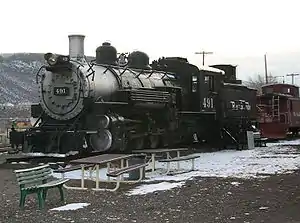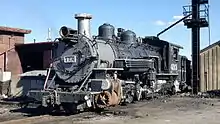Rio Grande class K-37
Denver & Rio Grande Western K-37s are a series of 2-8-2 "Mikado" type narrow-gauge steam locomotives. They were originally built by Baldwin as part of an order for thirty standard gauge 2-8-0 "Consolidation" type locomotives, class 190, in 1902. They were renumbered into class C-41 (meaning 41,000 lbs of tractive effort) during the railroad's reorganization in 1924 and were converted to 3 ft (914 mm) gauge in 1928-30 at the railroad's Burnham Shops in Denver, CO with many new parts including new frames and smaller drivers. They then became class K-37.
| Denver & Rio Grande Western K-37 | |||||||||||||||||||||||||||||||||||||||||
|---|---|---|---|---|---|---|---|---|---|---|---|---|---|---|---|---|---|---|---|---|---|---|---|---|---|---|---|---|---|---|---|---|---|---|---|---|---|---|---|---|---|
 D&RGW K-37 No. 491 on static display at the Colorado Railroad Museum | |||||||||||||||||||||||||||||||||||||||||
| |||||||||||||||||||||||||||||||||||||||||
| |||||||||||||||||||||||||||||||||||||||||
| |||||||||||||||||||||||||||||||||||||||||
| |||||||||||||||||||||||||||||||||||||||||
Design
The locomotives are of outside-frame design, with the driving wheels placed between the two chassis frames which support the boiler, but with the cylinders, driving rods, counterweights and valve gear on the outside. This general arrangement is shared with the earlier K-27, K-28 and K-36 Mikado type engines.
History
The locos worked out of Salida, Colorado to Gunnison, Colorado and up the Crested Butte Branch as well as the Monarch Branch. The locos also worked out of Alamosa, Colorado to Antonito over Cumbres Pass to Chama and on to Durango and the Farmington branch. Like the K-36s the locos were not permitted West of Gunnison or on the Silverton branch. However, the Silverton branch has since been upgraded the track and line to handle K-36s and K-37s. 3 of the K-37s, Nos. 493, 491 and 499, were equipped with steam heat and signal lines so they could haul passenger trains like the San Juan Express and Shavano.
Of the eight preserved K-37s, #497 has operated on the Durango and Silverton Narrow Gauge Railroad (D&SNG) from 1984 to 1991 and on the Cumbres and Toltec Scenic Railroad (C&TS) from 1992 to 2002. In 2014, locomotive #491 was restored at the Colorado Railroad Museum (C.R.R.M.); it operated for the first time in public on Saturday, September 13, 2014 at the annual Thomas the Tank Engine event. A ticketed "roll out" was hosted on August 29, 2014. On May 4, 2016, the D&SNG, in cooperation with the Colorado Railroad Museum, transported locomotive #493 to Durango after resting in Silverton for almost 20 years with the plan of having the C.R.R.M. transport it to Golden, Colorado and have it restored as well. However, after plans with the C.R.R.M. fell through, the D&SNG decided to undertake the restoration of #493 themselves. In the restoration process of #493 however, the locomotive was converted to oil-firing, making it the first and only so far ex-D&RGW "Mikado" to burn oil rather than coal.[3] On January 24, 2020, #493 moved under its own power for the first time in over 50 years, making it the first D&RGW K-37 class since #497 to run on the D&SNG. #493 then ran its first revenue run on the D&SNG on February 14, 2020.


Although the K-37s are actually about 2% lighter than the K-36s, they were erroneously thought to be much harder on track. The D&SNG originally owned four of the surviving K-37s, but they found that the #497 was too hard on their track and didn't handle the Animas Canyon section of the route as well as they would have hoped. Consequently, they traded #497 to the C&TS for K-36 #482 and #499 to Royal Gorge Park in Canon City for #486. However, the problems experienced by the D&SNG are now thought to have been isolated to locomotive #497's trailing truck and not universal to all K-37s.
Roster
The full roster of K-37 locos is:[4][5][6]
| Class K-37 Number |
Class 190 Number |
Class C-41 Number |
C-41 Builder's Number |
Rebuilt in |
Current Owner |
Notes |
|---|---|---|---|---|---|---|
| 490 | 1114 | 1014 | 20695 | 1928 | n/a | Retired in 1962. Dismantled between 1963-64. |
| 491 | 1126 | 1026 | 20829 | 1928 | Colorado Railroad Museum, Golden, CO | Retired in 1963. It was acquired by History Colorado in 1970. Then moved to the Colorado Railroad Museum in 1985; ownership of the engine was transferred to the museum in 2013. Restored to operating condition and debuted on August 30, 2014. Operational. |
| 492 | 1121 | 1021 | 20749 | 1928 | C&TS | To C&TS in 1970. Stored in Chama, NM. |
| 493 | 1105 | 1005 | 20550 | 1928 | D&SNG | Retired in 1968. Moved to D&SNG in March 1981. Restored to operating condition on January 24, 2020 as an oil-burning engine. Operational. |
| 494 | 1120 | 1020 | 20748 | 1928 | C&TS | Retired in 1962. To C&TS in 1970. Currently on display in Antonito, CO.[7] |
| 495 | 1104 | 1004 | 20522 | 1928 | C&TS | Retired in 1962. To C&TS in 1970. Currently on display in Antonito, CO.[8] |
| 496 | 1123 | 1023 | 20751 | 1930 | n/a | Dismantled in 1955. Subject of an April Fools' Day hoax in stating that it had been discovered intact in a barn near Salida, CO in 2011.[9] |
| 497 | 1103 | 1003 | 20521 | 1930 | C&TS | To D&SNG in March 1981. Restored to operating condition in 1984. Traded to C&TS for K-36 No. 482 in October 1991. Taken out of service in late 2002. Currently stored in Chama, NM inside the roundhouse. Awaiting a future overhaul.[10] |
| 498 | 1109 | 1009 | 20640 | 1930 | D&SNG | To D&SNG in March 1981. Stored in Durango, CO. |
| 499 | 1125 | 1025 | 20753 | 1930 | Royal Gorge Park Canon City |
Retired in 1970. To D&SNG in March 1981. Traded to Royal Gorge Park for K-36 No. 486 in 1999 for display. |
References
- Armitage, Alan B. (October 1979). "Denver & Rio Grande Western's K-37 MIkados". Model Railroader. Milwaukee: Kalmbach: 70–73.
- Official Roster No. 11 of the Denver and Rio Grande Western Railroad System. Denver: The Denver and Rio Grande Western Railroad System. April 1, 1923. p. 94.
- http://trn.trains.com/news/news-wire/2018/07/13-durango--silverton-looks-to-oil-firing-diesels
- "Denver & Rio Grande Western Mikados". Steam Locomotive dot com. Archived from the original on 21 September 2010. Retrieved 12 February 2010.
- "Denver & Rio Grande Western Roster". Rio Grande Modeling & Historical Society. Archived from the original on 22 November 2008. Retrieved 12 February 2010.
- "Durango & Silverton Steam". DRGW.net. Retrieved 12 February 2010.
- "2014 Trip - Alamossa & South Along U.S. 285 - Franks-Focus". Retrieved 2018-05-04.
- "K-37 #495". davesriogrande.net. Retrieved 2018-05-04.
- "Historic Steam Engine discovered in Barn". March 29, 2011. Retrieved December 20, 2011.
- "Chama and Durango". www.trevorheath.com. Retrieved 2018-05-04.